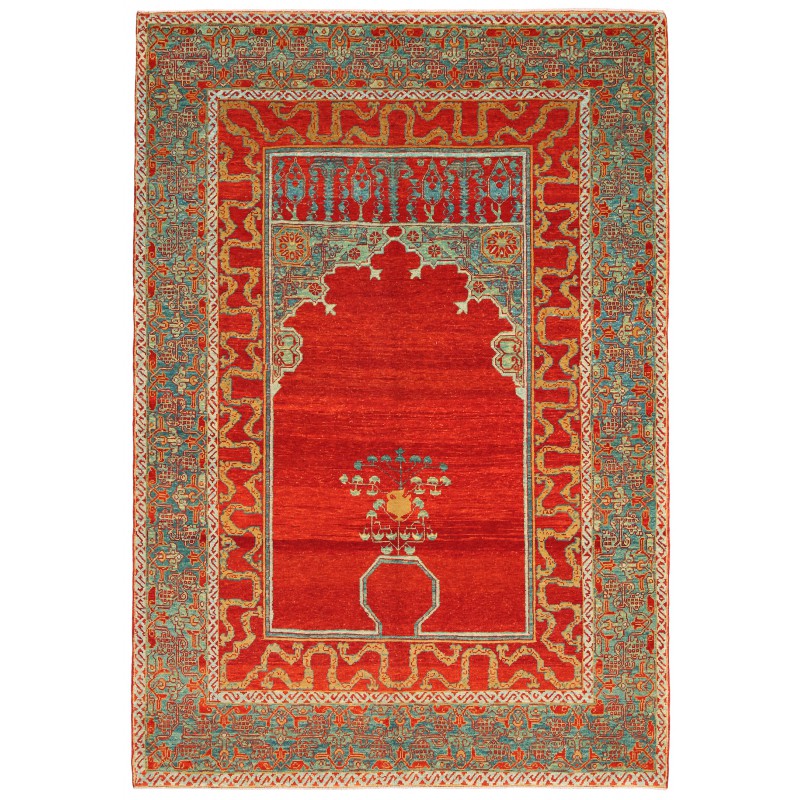
- Stock: 売り切れ
- Model: C40155
- サイズ: 143cm x 207cm
この絨毯の情報源は、ドイツのベルリンにあるペルガモン博物館のイスラム美術部門です。このクラウドバンドのある礼拝用絨毯は、エジプトのカイロのマムルーク朝のスルタンによって16世紀初頭にデザインされました。この絨毯は、デザインから見て礼拝用絨毯のグループに属していることを示しています。内部エリアは赤いアーチ形のミフラーブ(礼拝の方向を示すニッチ)で飾られています。ミフラーブの前には、上から見た水盤が配置され、細い線で描かれた緑の葉を持つ小さな木が浮かび上がっています。この木の中央には、取っ手と短い注ぎ口を持つ小さな黄色の水差しが組み込まれています。この水差しは、クルアーンの第5章第8節で述べられている礼拝前の儀式的な手洗いの義務を示している可能性があります。ミフラーブのアーチの角には、緑色の8つの角を持つ星が見えます。ミフラーブの上には、ヤシの木とスギの木が描かれた矩形のスペースがあります。内部エリアを2つのボーダーが囲んでいます。より細いボーダーは、装飾的なクラウドモチーフのバンドで埋められています。このクラウドモチーフのバンドは、オスマン帝国の芸術においては15世紀から16世紀にかけて一般的な特徴であり、中国が起源です。この絨毯では、黄色のクラウドモチーフのバンドが赤い背景に表示され、非常に近くに配置されています。絨毯のより広いボーダーは、軽い緑の背景に植物のモチーフを絡み合わせた連続したつる状のバンドで構成されています。
絨毯の象徴性は、ミフラーブのモチーフと楽園の庭園との関連性に由来しており、絨毯上での水のプールと木がそれを描写している可能性があります。クルアーンでは、イスラムの信仰を持つ者に対して楽園としての素晴らしい庭園が約束されており、美しい流れ、素晴らしい植物、美しい乙女(フーリス)がいっぱいの庭園で永遠に滞在することが示されています。
カイロの礼拝用絨毯は文献で頻繁に言及されていますが、この特定の絨毯は唯一現存するマムルーク朝の礼拝用絨毯です。この時期には、マムルーク朝のカイロとイタリアの間で活発な貿易も行われていました。この絨毯のデザインは、私たちのデザイナーによって解釈され、オリジナルに最も適した色が使用されています。
The source of the rug comes from the Museum of Islamic Art at the Pergamon Museum, Berlin, Germany. This prayer rug with cloud bands was designed in the early 16th-century rug by Mamluk Sultane of Cairo, Egypt. This carpet demonstrates through its design that it belongs to the group of prayer rugs. The inner area is adorned with a red-colored arch-shaped mihrab (prayer niche). Placed in front of the niche is a basin, seen from above, from which emerges a small tree with green leaves, rendered in a semi-abstract design with fine lines. A small yellow jug with a handle and short spout has been incorporated into the center of the tree. This jug may relate to Sura 5 verse 8 of the Qur’an, which mentions the obligation of ablutions to be undertaken before prayer. Green-colored, eight-pointed plaited stars can be seen in the corners of the Mihrab arch. Above the mihrab is a rectangular space filled with palms and cypresses. Two borders frame the inner area. The thinner border is filled by a decorative cloud-motif band. This cloud-motif band is a common feature of Ottoman art since the AH 9th and 10th / AD 15th and 16th centuries, and it originated in China. On this rug, the yellow cloud motif bands are displayed over a red background and are positioned very close to one another. The rug’s wider border consists of a continuous tendril-like interlacing band involving plant motifs, over a light-green background.
The rug’s symbolism derives from the connection between the mihrab motif and that of the garden of Paradise, which is perhaps what is being illustrated on the rug through the pool of water and the tree. Paradise, described as a wonderful garden, is promised at different points throughout the Qur’an to those who believe in the Islamic faith. Followers of Islam will one day arrive and stay in this garden full of lovely streams, wonderful plants, and beautiful young virgins (Huris).
Prayer rugs from Cairo are frequently mentioned in the sources, but this particular rug is the only surviving Mamluk prayer rug. It is particularly noteworthy for its incorporation of Mamluk motifs with those derived from Ottoman art, hence the reason for dating it to around AH 900 / AD 1500 or a little later.
Mamluk rugs can be seen in Italian paintings from the 15th and 16th centuries and moreover are mentioned in a great number of sources. During this period there was also a flourishing trade between Mamluk Cairo and Italy. The design of the rug is interpreted by our designers, and the most appropriate colors to match the original are used for this rug.
